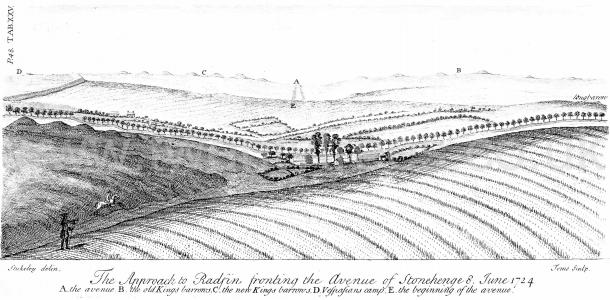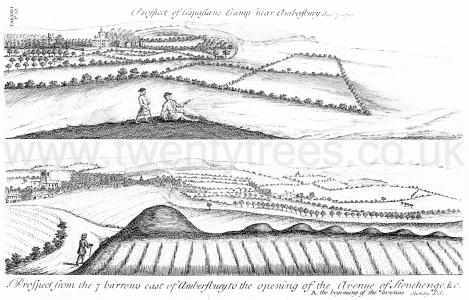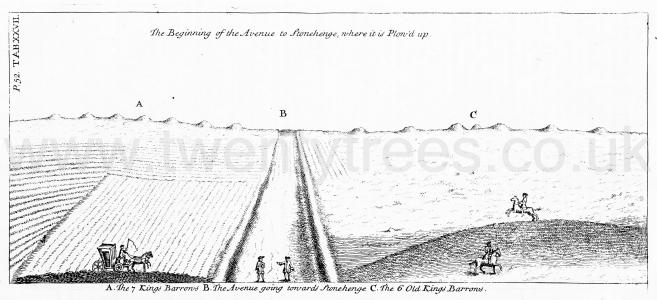Stonehenge Chapter XI
Stonehenge Chapter XI is in Stonehenge A Temple Restored To The British Druids By William Stukeley.
Of the original name of Stonehenge, and a conjecture of the general time of building such kind of works. Of Wansdike, by whom made and when. Of Vespasian's camp. Stonehenge was call'd the Ambers, or Main Ambres: which mean the anointed stones, i. e. the consecrated, the sacred stones. The meaning of the word Ambrosia. The Tyrian Hercules brought the Druids hither, with Abraham's religion. Apher a grandson of Abraham's, his companion.
I have inform'd the reader, to the best of my skill, what was, and what is the state of Stonehenge, both above, and below ground. I apprehend, it will be expected, that I should say somewhat, concerning the antiquity and time of erecting these works, especially of Stonehenge. But what can we say, of a matter so very remote? where the oldest memoirs and reports of the oldest nation inhabiting the island, can give us no satisfaction about it: but are as far to seek, as to the founders of this wonderful work, as we are, at this time, and are forced to apply to magic: in order to account for it. Notwithstanding, I shall endeavour to satisfy the readers curiosity, in this point, as well as I can; by giving him my own opinion about it. Not doubting of his candour, in so arduous an attempt: which may perhaps be an amusement to him, whether it gains his belief, or not. Therefore, I shall recite, in short, what occurs to me, on this subject. 1. As to the antiquity of these temples in general. 2. Of the time of founding Stonehenge.
The former will anticipate, in some sort, what I promis'd, in treating of the temples of the Druids in general. But I am naturally led to it, here, by observing, that the name of the adjacent town of Ambersbury, points out a relation to the work of Stonehenge, and to the ancient name of it. For as we took notice at first, the present name of Stonehenge, is purely Saxon, given by our latest ancestors, by a people wholly strangers to the purport of the thing, that had no notion, no report of its having once been a sacred place; and signifies no more than hanging-stones, or a stone-gallows. The ancient Britons call'd it choir-gaur, which the Monks latiniz'd into chorea gigantum, the giants dance; a name suited to the marvelous notion they had of the structure, or of the reports of magic, concern'd in raising it. But I had rather chuse to think choir gaur in Welsh, truly means, the great church; the cathedral, in our way of speaking. A general title, which the Welsh inhabitants, the remnants of the Belgæ, conquer'd by the Romans, gave it; as well knowing the true use of it, and even frequenting it in a religious way. Tho' they had driven off the first possessors of it, and the builders: I mean in Divitiacus his time, or sooner, before the Roman invasion.
There is a very plain reason: that Stonehenge was built, before the Wansdike was made, and that was the last boundary of the Belgic kingdom in Britain. The stones of which Stonehenge is compos'd, were fetcht from beyond that boundary, consequently then an enemies country. It seems not improbable, that the Wansdike was made, when this Belgic kingdom was at its height, and that time we may well guess at, from Cæsar. He tells us in Bell. Gall. Lib. II. 4. "the Belgæ are of German original. By force of arms, they possess'd themselves of the countries, south of the Rhine and towards the ocean, driving out the Gauls. They were a very warlike nation, and could produce 100000 men in arms. That one of their kings Divitiacus, in the memory48 of some then living, obtain'd the government, both of great part of Gaul and in Britain too." I believe the Belgæ and Sicambri, all one people of German original. Our Welsh call themselves Cymri, and from them Cumberland has its name. It is very just to think this Wansdike was made in the time of Divitiacus, both because of the greatness of the work, suiting so potent a prince, and because it is the last boundary: after that time, the Roman power swallowing up all divisions.
I judge, we may reasonably place the time of making the Wansdike, about 50 years before Cæsar wrote, we may say AUC. 650. Divitiacus probably ordered it to be made in person. And it seems to have been drawn from the upper end of the Tees river, about Whit-church, and Andover, in Hampshire: to the Avon river, about Bristol. These two rivers and the Wansdike separated the Belgic kingdom from the old Celtic Britons. They by this means, were driven from this beautiful country, and from their stately temple of Stonehenge, by these powerful invaders. It is remarkable enough, that the inhabitants of Somersetshire, the ancient seat of the Belgæ, retain still the Belgic, liquidating pronunciation, v consonant for f, z for s.
The Devizes is a town in the middle of the length of Wansdike, very probably erected, among others, to secure this ditch or fortification. It seems to have been the capital fort or frontier town, and to have its name from the king, as a trophy or monument of his power: built by him in person. Anonymus Ravennas may possibly call it Punctuobice, but we have no certainty, that his copy retains the word uncorrupt, or that he transcribed it right: nor what alteration the Romans made in the original word, nor what was made in the later and barbarous times. However there seems enough therein, as well as in the present name of the town, to countenance our conjecture. The former part of the word punctuo, which Mr. Baxter thinks monstrous, may come, perhaps, from the German word pooghen, which signifies an arduous work, and might regard the castle here, which is said to have been once, the strongest in Europe. Neubringensis calls it Divisæ. They tell us legendary stories of its being built by an old British king.
Divisus was probably the name of this Belgic Monarch, or Duiguis: as Gluiguis king of Demetia in Wales is wrote Glivisus in Toland, p. 186. and the termination may have been form'd into Latin, from the Celtic word taeog dux. Whence, perhaps, the Etruscan Tages, so much boasted of in their antiquities; likewise the modern Doge of Venice. So that Divitiacus may well be Divisus dux. The name of the Wansdike, I shewed to be purely Celtic, p. 4.
It is an ancient oriental custom to make these boundary ditches. Thus the land belonging to the several tribes of Israel was marked out by a ditch, as we read in the accounts of the holy land. Particularly the author of le voyage de la terre sainte, printed 1675. Paris, p. 57. says, "he travell'd five or six miles along such a ditch going from Joppa to Jerusalem, which parted the tribes of Benjamin and Judah." 'Tis recited Joshua xv.
The monkish writers make much ado about Aurelius Ambrosius, a christian king of the Britons (in the time of our great ancestor Hengist) building Stonehenge, by the help of Merlin Ambrosius the magician, in memory of the British nobility slain treacherously by Hengist, at Ambresbury. Some say the fact was committed ad pagum Ambri, others call it cœnobium Ambrij, others ad montem Ambrij. One while they refer the name to Ambrosius, another time to an Abbot Ambrius, and this was among our Roman British ancestors, who were christians. They add too, that Merlin fetch'd these stones out of Ireland, that they had been brought before, out of Africa into Ireland: that he set them up here in the same form, by art magic; and that the stones were of a medicinal Virtue. These matters we read in Girald. Cambrens. de admirand. Hib. c. 18. Higden's Polychron. v. Geoff. Monmouth VIII. Matt. Westminster, &c.
Table XXV. The Approach to Radfyn [Map] fronting the Avenue of Stonehenge. 8 Jun 1724. A. the avenue [Map]. B. the old Kings Barrows. C. the new Kings barrows. D. Vespasians camp [Map]. E. the beginnings of the avenue.

This calls to my memory, what the above-mention'd Dr. Harwood inform'd me, he had heard the great Sir Christopher Wren say, that there were such structures as Stonehenge, in Africa, being temples dedicate to Saturn. But I need not be tedious in observing, how absurd the Monkish reports are; of a christian king erecting Stonehenge, as a sepulchral monument for the British nobility, massacred in the monastery of Ambresbury. At the same time they say, their bodies were buried in the church-yard of the monastery. Nor how they confound the names of Ambrosius the king, Ambrius the abbot, the town, abby and mountain of Ambry, and perhaps of Merlin too, for one of them was call'd Ambrosius. But their affirming, the edifice came out of Africa into Spain, thence into Ireland, thence into Britain, and of its being erected here in the same form, by art magic; and that the stones are of a medicinal virtue: these notions lead us to the original truth, of the Druid founders, and that Stonehenge had originally, the name of Ambres, and from it the adjacent town of Ambresbury had its name.
To pursue this matter a little further. Between Stonehenge and the town, hanging over the river, upon elevated ground is a fine and ancient camp, commonly call'd Vespasian's, and not without much probability, attributed to him. We have often had occasion to mention it before. That great man, destin'd by providence for executing his final vengeance, on the people of the Jews, and thereby accomplishing our Saviour's predictions; by his successes in this place, pav'd a road to the imperial dignity. Having conquer'd the isle of Wight, he pursued his good fortune, higher up into this country, where he made this camp, and another across the heath, call'd Yanesbury; which seems to retain the latter part of his name. The camp we are speaking of near Ambresbury, is an oblong square, nicely placed upon a flexure of the river, which closes one side and one end of it. There is an old barrow inclos'd in it, which, doubtless was one of those belonging to this plain, and to the temple of Stonehenge, before this camp was made. It is pretty to observe, that the road from Stonehenge to Ambresbury, runs upon the true via prætoria of the camp. The Generals tent or prætorium was in that part south of the road, between it and the river, toward little Ambresbury. There is another gate of the camp, at the lower end, northward, the porta prætoria ordinaria, in the Roman language. Now I apprehend, that Stonehenge was originally call'd the Ambres, from thence this camp was call'd Ambresburgh, and thence the name of the town underneath.
Mr. Camden writes, "that near Pensans in Cornwall, is a very remarkable stone, call'd main Ambre, which tho' it be of a vast bigness, yet you may move it with one finger: notwithstanding a great number of men cannot remove it from its place. The name is interpreted the stone of Ambrosius." A picture of it in Norden's history of Cornwall, p. 48. I have seen one of these rocking stones, as call'd commonly, in Derbyshire. Mr. Toland in his history of the Druids, mentions it too, and says there are such in Wales and in Ireland. Sir Robert Sibbald mentions them in Scotland, all rightly judg'd to have been done by the Druids. Sir Robert speaking of the rocking stone near Balvaird (or the Bards town) in Fife: "I am inform'd (says he) that this stone was broken by the usurper Cromwell's soldiers. And it was discover'd then, that its motion was perform'd, by a yolk extuberant in the middle of the under surface of the uppermost stone, which was inserted in a cavity, in the surface of the lower stone." This is the artifice of the stones at Stonehenge, but applied here by the Druids for a moveable principle, as there, for stability. I call them mortaise and tenon: and before observ'd them to be of an egg-like form; which Sir Robert calls a yolk. The Main Amber in Cornwall was likewise destroy'd in the civil wars, by one of Oliver's governors. These reformers had a notion of these works being superstitious matters. Main Ambre is lapis Ambrosius, or petra Ambrosia. And that name leads us to consider the famous50 petræ Ambrosiæ, on the coins of the city of Tyre. A specimen of them, I have drawn on the Plate following.

These, and many more of the like sort, struck by the city of Tyre, in honour of their founder Hercules, may be seen in Vaillant's second Volume of colony coins, pag. 69, 148, 218, 251, 337.
They represent two great, rough stones, call'd petræ ambrosiæ, with an altar before them, and an olive tree; Hercules the hero of Tyre, the famous Navigator of antiquity, their founder, sacrificing. On some of the coins petræ ambrosiæ wrote in Greek. He is represented indeed like the Greek Hercules, but in the latter times of the Roman empire, when these coins were struck, they at Tyre were as far to seek about the true meaning and origin of their first antiquities, as we of ours. And what knowledge they had of them, was from legendary reports of the Greeks, who chiefly, among the heathens, had the knack of writing. These reports, as we may find in Nonnus his Dionysiacs, 40. and 41. acquaint us, that Hercules invented shipping, as a latin poet too intimates, Tibullus.
Prima ratem ventis credere docta Tyrus.
They acquaint us that he ordered Tyre to be built, where the petræ ambrosiæ stood, which were two moveable rocks, standing by an olive tree. He was to sacrifice on them, and they should become fixt and stable: rather, the City should be built with happy auspice, and become permanent.
Here are our Main Ambres, made artfully moveable, a kind of altars, or pillars, the same as the pillars of Hercules so fam'd, and as little understood. They were the original patriarchal altars, for libations and sacrifices, and mean, in general, their Altars, whether moveable or immoveable: or as we may speak, their temples, which imply an altar properly, inclosed with stones and a ditch, or ground dedicated and set apart for public celebration of religious rites. For the word Ambrosius means in general, consecrated, dedicated to religious use.
Beside the petræ ambrosiæ of Tyre, and our main ambres of Britain and Ireland, we meet with another in Hephæstion's History III. 3. "Speaking of Hercules, he mentions the Gygonian stone, as he calls it, near the ocean, which may be mov'd with the stalk of an asphodel, but can't be remov'd by any force." It seems this word Gygonius is purely Celtic. For gwingog signifies motitans, the rocking stone; and gwgon is what the boys with us call a gig, or little top. For these Gygonian stones are of that shape, pyramidal.
Table XXVI. Prospect of Vespasians Camp [Map] near Amberfbury. Augst 7. 1723. Prospect from the 7 barrows east of Amberfbury to the opening of the Avenue of Stonehenge & c. A. the beginning of the avenue [Map]. [This appears from the text to be a view from Haradon aka Telegraph Hill [Map]]

No wonder these matters are well nigh lost, in the mist of extreme antiquity, when even the meaning of the word ambrosius was hardly known, either to the antients or moderns, till Mr. Baxter discover'd it, in his glossary. It signifies oil of roses, rosaceum: the most antient kind of perfume. In the 4th Odyssy, v. 445. Edothea a sea goddess, teaches Menelaus and his companions, to cure the odious smell of the sea calves.
Ἀμβροσίην ὑπὸ ῥῖνα ἑκάστῳ θῆκε φέρουσα
Ἡδὺ μάλα πνείουσαν.——————
She put ambrosia to their noses, sweetly smelling. Again, in his hymn to Venus, the graces washt the goddess, and anointed her with oil ambrosial: such as becomes the immortals.
——————καὶ χρῖσαν ἐλαίῳ
Ἀμβρότῳ, οἷα Θεοὺς ἐπενήνοθεν αἰὲν ἐόντας.
Lastly, in Iliad. XXIII. Venus anoints Hector's body with ambrosial oil of roses,
———ῥοδόεντι δὲ χρῖεν ἐλαίῳ
Ἀμβροσίῳ———————
Which is a tautology. For from length of time, they scarce knew the true meaning of the word in Homer's age.
Virgil seems to understand but somewhat of the original meaning of the word, speaking of Venus; her hair was anointed with ointment perfum'd.
Ambrosiæq; comæ divinum vertice odorem
Spiravere————————— Æneid.
In Pliny Nat. Hist. XIII. 1. we find the oleum rhodinum most antient, common and simple. And this is the true ambrosia, which from its very antient use in sacred rites, had almost lost its meaning; and was us'd to signify, one while, the food of the gods, another time, immortality; again, whatever is divine, or appropriate to the gods. But simply, it signifies oil of roses, still from its first use, in sacred matters, it imports anointed, in a religious sense; consecrated, dedicated. Then main ambres, ambres, petræ ambrosiæ, signify the stones anointed with holy oil, consecrated; or in a general sense a temple, altar, or place of worship.
The truth is, it was a patriarchal custom to consecrate their altars, pillars, or in a general word temples, by anointing with oil, either simple or perfum'd. Rose oil being the oldest, engross'd the general name of the action; so that a stone anointed with oil of roses, is a main amber, or lapis ambrosius. The same is an altar, or stone dedicate to religious use. The plural number, petræ ambrosiæ, import a church or temple, in our way of speaking.
We have an illustrious instance of this practice in the holy Scriptures, and the earliest. Gen. xxviii. This is not commonly understood by writers. 'Tis the moving and memorable history of young Jacob, sent away from his father's house alone, to take a long journey to some unknown relations. He came to a place, call'd afterward Bethel, and sleeping with his head on a stone for a pillow, had a celestial vision; and a promise from God, of the highest importance to him and all mankind. Awaking, he thought the place had been holy ground, where, perhaps, his grandfather Abraham had before-time built an altar; an house of God, or gate of heaven, as he elegantly names it. "Therefore he rose up early in the morning, which was one circumstance (in52 patriarchal times) of the work he was going about, and took the stone that he had put for his pillow, and set it up for a pillar; and poured oil upon the top of it, and called the place Beth-el, i. e. the house of God. Then he vowed, that if God would please to prosper him in his journey, and bring him back into his own country, he would build a temple there, and consecrate to God the tythe of his substance, as was the manner in those times."
This is in reality a votive, patriarchal temple, altar or house of God, which he not only vows to build, but at the same time endows it. The stone which Jacob anointed, was not an altar properly, lying on the ground whereon to make a libation, but he set it up as a pillar. It was one of the upright stones, which the scripture calls pillars, as standing of itself; a part of the circle of stones, inclosing the altar. And by the act of anointing, Jacob consecrated it, as the manner then was, destined it for a sacred purpose, as an earnest of his will in good time to fulfil it. And this he did fulfil, chap. xxxv. building the celebrated temple of Bethel. Here Jeroboam set up one of his golden calves. At last it was destroy'd by Vespasian.
In Exod. xxiv. 4. "we have an instance of Moses rising up early in the morning and building an altar, and setting up 12 pillars around it." This was before the tabernacle was made, which introduced the custom of cover'd temples.
But so famous was that patriarchal temple of Jacob's, which he built at Bethel; that the heathen called all their temples of that sort, when they were perverted to idolatrous purposes, Bæthylia, lapides Bætyli, and the like. Which indeed is but another manner of expressing lapis Ambrosius, or our Main Ambre. And according to custom, the fabulous Greeks having lost the true history of its origin, affix'd many strange stories to it; as of Saturn devouring such a stone, wrapt up in a skin, instead of his Son Jupiter: which seems to be form'd from the memory of praying at these places, in the name of the mediatorial deity, as the patriarchs did. And Sanchoniathon tells us, the god Ouranus devised Bætylia, or animated stones. He means our rocking stones, gygonian stones. I shall show in my discourse on that subject, that by Ouranus, he means righteous Noah, who, according to patriarchal usage, builded an altar unto Jehovah, Gen. viii. 20. meaning one of these patriarchal temples. In time, by the corruption of mankind, these places were desecrated to idolatrous purposes; and writers pervert the intent of them. So that God Almighty, raising up the Mosaic Dispensation, was oblig'd to interdict the very use and practice of these open temples, and introduce the cover'd one of the tabernacle; by way of opposition to heathenism, as well as with other important views.
We find now the meaning of anointed stones in antiquity, and the olive-tree set by the stones on the Tyrian coins. As the very learned Author of Archæologia Græca observes, on the affair of consecration, "they were more or less sumptuous and expensive, as other parts of divine worship, according to the ability of the worshippers." Young Jacob a traveller us'd plain oil, part of his viaticum, others us'd perfum'd oil, or ambrosia. That author cites us from Athenæus, the method of consecrating Jupiter Ctesias's statue with a libation call'd ambrosia: and others by anointing with oil, prayers and libations, Exodus xxx. 22. We have the holy precious ointment made under the Jewish dispensation for the like purpose. And we use such, for inauguration of our kings, to this day.
The Tyrian Hercules who built Tyre and set up the petræ Ambrosiæ in those coins, (if I mistake not) liv'd as early as the time, of Jacob's anointing the stone at Bethel. The great Bochart, who penetrated very deep into the Phœnician learning, looks upon it as a clear matter, that in Joshua's time, the Phœnicians sent innumerable colonies, into the mediterranean coasts, and even to the ocean. In the preface to his admirable work Canaan, he says, "he has a great suspicion, that colonies went abroad this way, before that time. Particularly, he asserts, that Hercules, in Eusebius sirnamed Desanaus, 53who was famous in Phœnicia before the Exodus, is the same, who conquer'd Antæus in Africa: which in Eusebius, is set 56 years before. He is call'd Hercules primus, and that is 63 years before the Exodus, in Eusebius's chronology." Again, he judges it to be 2000 years distance between the later Roman times and the first Hercules. Now from Constantine the great, 2000 years carries us up to Jacob's time. And he proves, from Aristotle de mirabilibus, that Hercules built Utica in Africa, at that time; wherein Eusebius says he was famous in Phœnicia, and this must be when Hercules was old. He having conquer'd Antæus in that country, when he was young.
Table XXVII. The Beginning of the Avenue [Map] to Stonehenge, where it is now Ploned up. A. The 7 Kings Barrows B. The Avenue going towards Stonehenge C. The 6 Old Kings Barrows.
